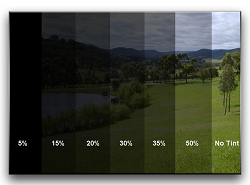Window Tint Shades and Colors

Before having a car or truck tinted it’s likely you’ll want to decide on a shade and color first. There are several different selections
of shades and colors to choose from.
Dye/Metal Film
Most commonly this film is constructed with a polyester layer with dye and metal combined into the film. This gives the film its
ability to inhibit heat transfer. This type of film is generally considered to be a premium film and most manufactures offer a
Lifetime Warranty. The color is charcoal and this is what has been used throughout the window tinting industry for years. Bronze
color is also available from most manufacturers but the charcoal color is what customers traditionally prefer. This film is a
good product for customers who want a crisp appearance, good heat rejection and protection from the UV for you and your
automobile's interior. Most (but not all) of these types of auto tint with the Dye/Metal construction are color stable
for 2 to 5 years depending upon your circumstances (such as use of covered parking or a garage). Although the Dye/metal film
manufacturers do not offer a color fade warranty they do offer a Lifetime Warranty against film defects such as bubbling, peeling
and distortion.
Carbon Film
This film is constructed with Carbon. Most manufacturers have a standard or general grade type of carbon tint/film. All of the
carbon films come with a color fade warranty and a Lifetime Warranty. The standard or general grade carbon window tint does not
block as much heat as the Dye/Metal window tint. The carbon films look similar to the Dye/Metal films.
Top Quality Carbon Film
Most manufacturers also offer a lifetime warranty on extreme or high-end Carbon grade film. The extreme carbon films actually
block more heat than the traditional Dye/Metal films. Other benefits with the high end extreme carbon film include optical
clarity and durability. It is one of the nicest looking window films/tint available today on the market.
Basic Film
Basic auto window tint is constructed with a layer of polyester and dye placed in the adhesive/glue. This basic film does not
contain metal. The basic film finish or color is usually referred to as smoke. The basic auto tint has the lowest amount of
heat rejection but it will reduce fading to the interior upholstery and is very inexpensive. The basic auto tint rapidly changes
in color and scratches easily. You might be lucky to get a year or maybe two before the basic auto film turns purple.
How Tint Shades Are Measured
Window film is measured in a percentage of visible light transmitting through the film, more commonly referred to as VLT
(Visible Light Transmittance). For example, a window with 50% visible light transmittance (VLT) tint is letting half of
visible light pass (transmit) through. Window tinting experts consider 5% VLT tint and lower to be limousine tint.
There are many variations in VLT-percentage of automobile and commercial/architectural window tint. Window film can range
from clear to opaque.
 Before having a car or truck tinted it’s likely you’ll want to decide on a shade and color first. There are several different selections
of shades and colors to choose from.
Before having a car or truck tinted it’s likely you’ll want to decide on a shade and color first. There are several different selections
of shades and colors to choose from.

 Before having a car or truck tinted it’s likely you’ll want to decide on a shade and color first. There are several different selections
of shades and colors to choose from.
Before having a car or truck tinted it’s likely you’ll want to decide on a shade and color first. There are several different selections
of shades and colors to choose from.